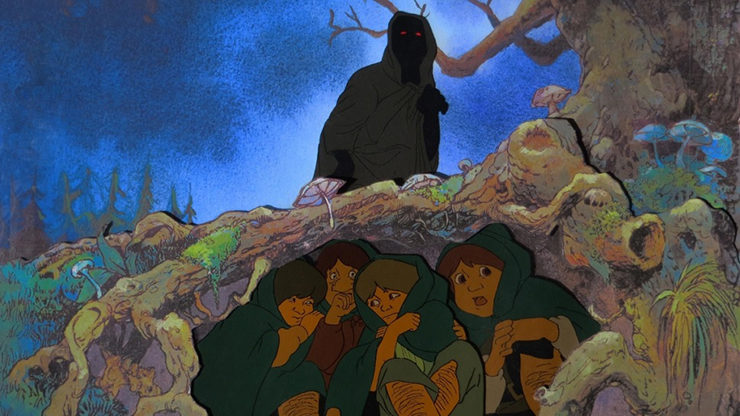In a previous article, I wrote about how Rankin/Bass’s TV movie The Hobbit , which debuted the same year as Star Wars, served as a prophecy for the future of entertainment. These days, Tolkien’s legendarium isn’t just mainstream: it’s the foundational text of mainstream pop culture, from Harry Potter to Game of Thrones to Star Wars —Tony Stark even calls Hawkeye “Legolas” in The Avengers.
It wasn’t always so. In the 1970s, the main places for Middle-earth references in the greater pop culture were Rush and Led Zeppelin songs, and graffiti declaring “Frodo Lives” on subway station walls. Tolkien was a conservative Oxford don, but The Lord of the Rings had found its first popularity in the counterculture.
It’s fitting, then, that the first person to bring Tolkien to the big screen was the counterculture cartoonist Ralph Bakshi, aided by screenwriter and The Last Unicorn author Peter S. Beagle. Most famous for the X-Rated cartoon Fritz the Cat , Bakshi brought a distinct artistic approach to The Lord of the Rings that simultaneously fit its countercultural caché and helped to bring the story out of funky hot-boxed rooms filled with lava lamps and into a more mainstream consciousness.
Bakshi’s film opens with a prologue showing the forging of the Rings of Power, the war of the Last Alliance, the snaring and transformation of Gollum, and Bilbo’s finding of the One Ring. It’s beautifully rendered as black shadows cast against a red canvas, making the history of Middle-earth look like a shadow play cast against the walls of a cave with a flickering fire, or maybe a medieval tapestry come to life. It also introduces the driving artistic technique of the movie: a mix of pure animation, painted backgrounds, and rotoscoping (a technique Bakshi used where live action footage is painted over to match the animation).
We then cut to Bilbo’s 111th birthday party in the Shire, where we are introduced to Frodo, Gandalf, and the hobbits of the Shire, including the Proudfoots … er, “Proudfeet!” (a shot Peter Jackson would put directly into his own version of the story). Bilbo announces he’s leaving, then suddenly vanishes amidst some sparkles and rainbow flashes as he slips on the Ring. (You have to appreciate all the nice little touches Sauron apparently built into the One Ring.)
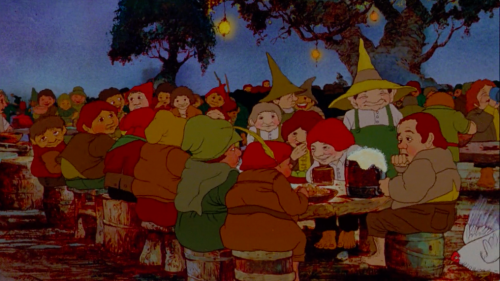
Gandalf confronts Bilbo back at Bag-End, where they fight over the One Ring. Where Rankin/Bass’s Gandalf came off like a deranged street preacher, Bakshi’s has the vibe of a stoned-out guru, complete with a lot of spooky hand gestures and pointing. Bilbo reluctantly surrenders the Ring and then leaves the Shire. (Which, I should point out, is beautifully painted. Rankin/Bass presented Bag-End all by itself, without showing us the rest of the community, but Bakshi puts it square in the middle of a busy neighborhood of hobbit holes. I wanted to move there immediately.)
Unlike in Jackson’s films, which compress the timeline considerably, Bakshi’s version tells us that seventeen years pass in the Shire. Frodo is the new master of Bag-End, though the One Ring is near enough that he hasn’t aged. This Frodo still looks and acts like a teenager, prone to lashing out and making poor decisions. He doesn’t have the haunted wisdom that Elijah Wood brought to the role, but his childlike nature makes his journey, and his burden, that much more compelling.
Buy the Book
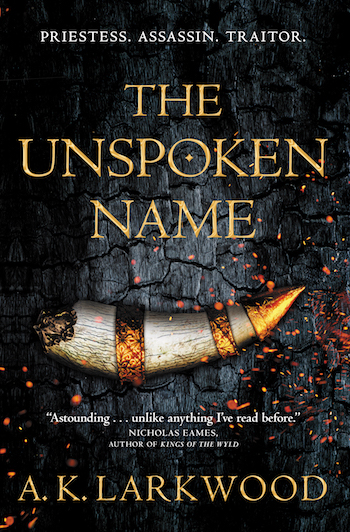

The Unspoken Name
Gandalf returns and, with an abundance of hand gestures, reveals the true nature of Frodo’s ring during a walk. They also catch Samwise Gamgee spying from the bushes. Sam is the most exaggerated of the hobbits in appearance, with fat puffy cheeks and a fat nose, and a voice like a bumbling constable in a cozy British murder mystery.
A plan is made: Frodo will move to Buckland for safety, while Gandalf seeks aid from his superior Saruman—or “Aruman,” as everyone mostly calls him (this is presumably Bakshi’s way of making sure audiences didn’t confuse Saruman and Sauron, especially given that they’re both evil sorcerers who live in black towers and command armies of Orcs).
Orthanc is the first Middle-earth location we get that is substantially different from other versions. It’s not a single smooth tower, as in the books and Jackson’s films—it’s a hodgepodge pile, its inside an Escher-like labyrinth chock-full of books, weird statues, and other wizarding bric-a-brac. I loved it. It absolutely looks like the home of an ancient wizard who’s lived there for centuries and has slowly gone mad with a lust for power after getting a little too obsessed with his dissertation topic.
(S)aruman (the ‘S’ isn’t silent, but it is optional) has a leonine look, his tiny face framed by a vast mane of white hair; his fingernails are sharp and pointy. Gandalf begs him for help, but unlike with Christopher Lee’s delightfully arrogant and serpentine Saruman, this (S)aruman is clearly already Full Evil. He rants and raves and then opens his red cloak…and the entire background turns into a trippy rainbow light show and suddenly Gandalf is imprisoned in a Lisa Frank painting on top of Orthanc. It’s weird and magical and very effectively establishes the mind-bending powers of the Istari. Bakshi is a genius at using animation techniques to give us a real sense of the fantastic.
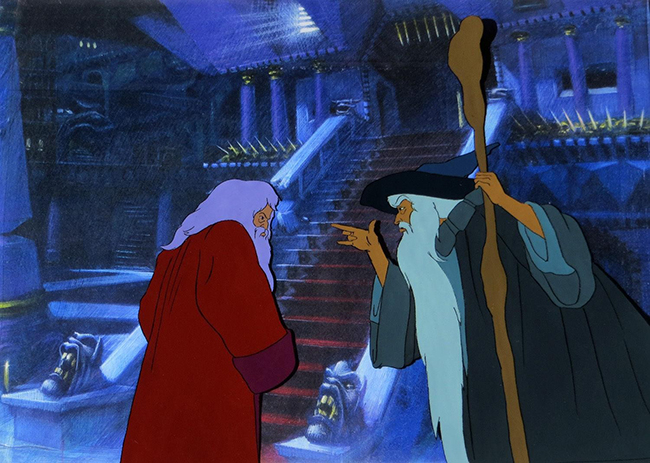
Meanwhile, Frodo, Sam, Merry, and Pippin (who, as in the books, have come along because they know about the Ring) are heading towards Buckland when someone approaches on horseback. They hide under a tree root just off the road as a Black Rider approaches. The camera frames the hobbits cowering under the roots while the Rider towers over them. It’s a wonderfully scary framing of the Nazgúl—one so good that Jackson would lift it more or less shot for shot in his movie (whether it’s a rip-off or homage, I’ll leave to you).
Bakshi’s Nazgúl shamble and limp like zombies, giving them a truly creepy feeling. Understandably unsettled, the hobbits decide to skip Buckland—and also the Old Forest, Tom Bombadil’s house, and the Barrow-downs—and head straight to The Prancing Pony in Bree.
The Pony’s common room hosts a rowdy, smoky party, and Bakshi puts his rotoscoping technique to great use here, using it to depict the Men while the hobbits stay traditionally animated. This gives the Men a leering, uncanny, almost sinister aspect, in a way that brilliantly underscores the sense that the little hobbits have wandered far from home, and into the wider world.
One Man who isn’t rotoscoped, at least not yet, is Aragorn, son of Arathorn. Sporting a Prince Valiant haircut, a broken sword, a green cloak, a huge belt, no sleeves, really nice legs, and no beard, Bakshi’s Aragorn (voiced by John Hurt) is a harder, grumpier version of the character than Viggo Mortensen’s. He certainly does look and act like a dude who’s spent the better part of eight decades shitting in the woods and fighting wolves.
Aragorn leads the hobbits out of Bree and through the Midgewater Marshes to Weathertop. He briefly tells them the story of Beren and Lúthien, emphasizing that Beren was Lúthien’s love but also her “doom.” Bakshi is clearly setting up an Arwen plotline that was sadly never to be realized. Then the Nazgúl attack and Bakshi’s use of rotoscoping works wonders in this scene: The Nazgúl, in their rotoscoped true wraith forms, advance on the hobbits. The rotoscoping makes them appear truly otherworldly and terrifying—even more so when Frodo slips on the Ring and enters the shadow world.
Gollum is often interpreted as a sort of drug addict in his all-encompassing need for the Ring, but Bakshi’s rotoscoped and background-painted wraith world really does make the Ring seem like a bad trip. It’s hallucinatory and strange, and connected to the real world just enough to be nauseating and that much scarier. And Frodo’s bad trip lingers, thanks to the knife-wound he receives from the Nazgúl. Even at the Ford of Bruinen, he’s still stuck in this rotoscoped nightmare, the Nazgúl leering and taunting him until the flood finally washes them away. The entire sequence is unsettling and unnerving.

Bakshi brilliantly upends our expectations of the hero’s journey in this film. Rather than striking out of a grounded real world into an increasingly strange fantasy world, Frodo journeys from the lush, cartoonish Shire into a shadow world all the more terrifying for its realism. The Shire, Bakshi seems to be saying, is the fantasy. The real world is the one Frodo glimpses through the Ring: the rotoscoped wraith world, the world of the Nazgúl, the Orcs, and war. We live in the world Sauron has made.
Fortunately for Frodo, he makes it to Rivendell where Elrond heals him and he’s reunited with Gandalf, who was rescued from Orthanc by a convenient eagle. Bakshi’s Rivendell looks like a Tibetan monastery built into a cliff, and there’s an implied idea of Elvish wisdom and magic being akin to Buddhism, yoga, and other elements of Eastern culture that the counterculture co-opted in the 70s.
It’s here that we meet Elrond (who is sadly mundane compared to Rankin/Bass’s star-circled vampire-wizard) and the Fellowship is formed. Its members are the hobbits, Gandalf, Aragorn, pretty boy Legolas (who subbed in for Glorfindel in the earlier race to Rivendell), Gimli the Dwarf (who looks less like a Son of Durin and more like a Packers fan with strong opinions on table saws), and Boromir (who, for some reason, is dressed like a Viking).
The Fellowship fails to climb over the Misty Mountains, so Gandalf decides to lead them under, through the Mines of Moria. Bakshi brings the Doors of Durin to beautiful life—though Legolas passively-aggressively tells Gimli he doesn’t know why the Dwarves even bothered to lock up a gross old pit like Moria, anyway. Dwarves may be more resistant to heat than the other Free Peoples, but poor Gimli just got burned.
Gandalf finally figures out the riddle, but before anybody can celebrate, the Watcher in the Water attacks. The Fellowship runs into the Mines, and then the Watcher, rather than pulling the doors down, dramatically slams them shut. The Watcher is, possibly, just sick of listening to the Fellowship arguing by its lake.
Like Orthanc, the Mines of Moria have a delightfully Escher-like look and feel, though it’s not long before the Fellowship is attacked by Orcs. Like the Nazgúl, the Orcs are entirely rotoscoped. They’re black-skinned with fangs and glowing red eyes. It’s a little disappointing that we don’t get a delightfully grotesque creature design, but they are quite scary, and the rotoscoping gives the fight a physical heft that most animated battles usually lack.
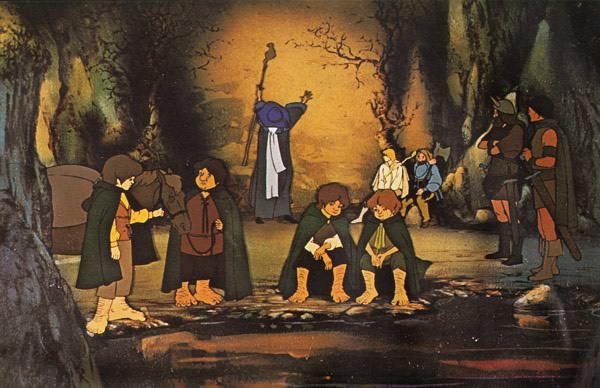
Then comes the Balrog, who looks like a lion with bat wings, and moves with the speed and urgency of the William Henry Harrison robot in Disney’s Hall of Presidents. Bakshi comes down squarely on the “Balrogs Have Wings” side of the Most Divisive Question in Tolkien Fandom, and his Balrog even flies…though he still goes tumbling down into the abyss with Gandalf a few minutes later. Perhaps when Gandalf yelled, “Fly, you fools!” he was talking about the Balrogs.
Aragorn is now in charge and urges the Fellowship on to Lothlórien. As in the books, Boromir objects, since the people in Gondor believe that the Golden Wood is perilous. Jackson gives that line to Gimli in his movies, which is fine, I suppose, but the fear the Gondorians and Rohirrim feel towards Lórien and Galadriel is important for understanding why Middle-earth is so vulnerable to Sauron: Men and Elves are estranged, indeed.
We cut directly to the Fellowship’s meeting with Galadriel and her husband Celeborn (mispronounced as “Seleborn”—I guess the ‘S’ sound from Saruman’s name drifted over from Isengard to the Lord of the Golden Wood). Afterwards, Frodo and Aragorn listen to the Elves singing a song about Gandalf. Unlike the mournful version in Jackson’s film, this one is sung by a children’s choir and is a little too hymn-like for my tastes. But it does lead to my favorite line of dialogue in the movie…
Bakshi mostly sticks to Tolkien’s original dialogue, but here he (and presumably Beagle) include a line where Aragorn tells Frodo that the Elves’ name for Gandalf was “Mithrandir.” Then he adds that of all Mithrandir’s many names, “I think he liked Gandalf best.”
Reader, I was delighted! The line is striking not only for being invented, but for being so good I wish Tolkien had included it in the books. It shows Bakshi and Beagle’s bone-deep knowledge and respect for the character and Tolkien’s world. And it’s a perfect encapsulation of Gandalf’s personality and history: he was a powerful wizard respected by the immortal Elves, even Noldorin royalty like Galadriel, but he felt most at home among the humble hobbits.
We cut again, this time to the Mirror of Galadriel scene. Bakshi’s Galadriel is much more down to earth than Cate Blanchett’s. She even delivers the “All shall love me and despair” monologue while twirling around. It doesn’t pack much punch, but then the Fellowship’s quickly out of Lorien, down the river, and past the Argonath, where they make camp.
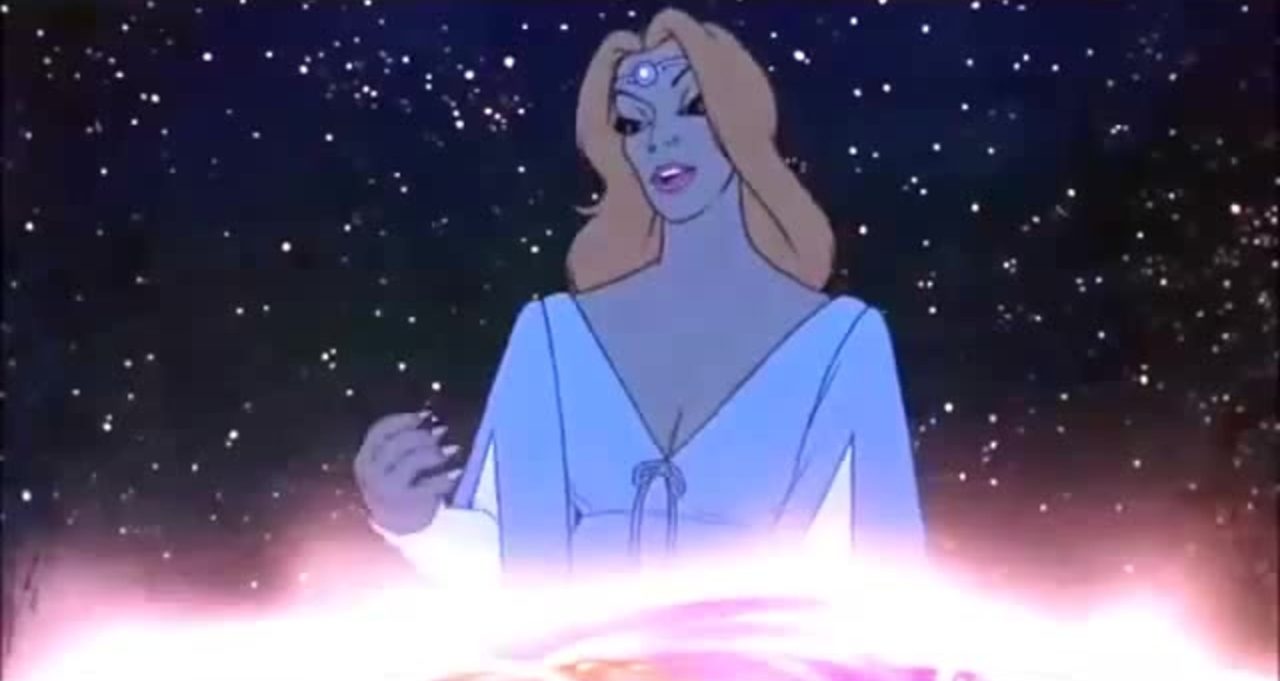
Aragorn doesn’t know what to do next, and Frodo goes off for an hour to ruminate. Boromir follows him and tries to take the Ring, Frodo runs off, Orcs turn Boromir into a pin cushion and kidnap Merry and Pippin.
Sam goes after Frodo and they paddle off together towards Mordor, while Aragorn decides to let Frodo go and pursue the Orcs to save Merry and Pippin. And then the movie fades to—
Wait, the movie is still going.
Bakshi’s The Lord of the Rings (originally subtitled Part 1 ), adapts both The Fellowship of the Ring and The Two Towers , and was intended to be the first of two movies, the second of which would cover the events of The Return of the King . Unfortunately, Bakshi never got to complete his duology, though Rankin/Bass returned to Middle-earth to do the job for him…with mixed results.
Next time, we’ll cover The Two Towers portion of Bakshi’s The Lord of the Rings, unless Tor.com fires me and hires Rankin/Bass to do it instead.
Originally published in November 2018.
Austin Gilkeson formerly served as The Toast ‘s Tolkien Correspondent , and his writing has also appeared at Catapult and Cast of Wonders . He lives outside Chicago with his wife and son.










